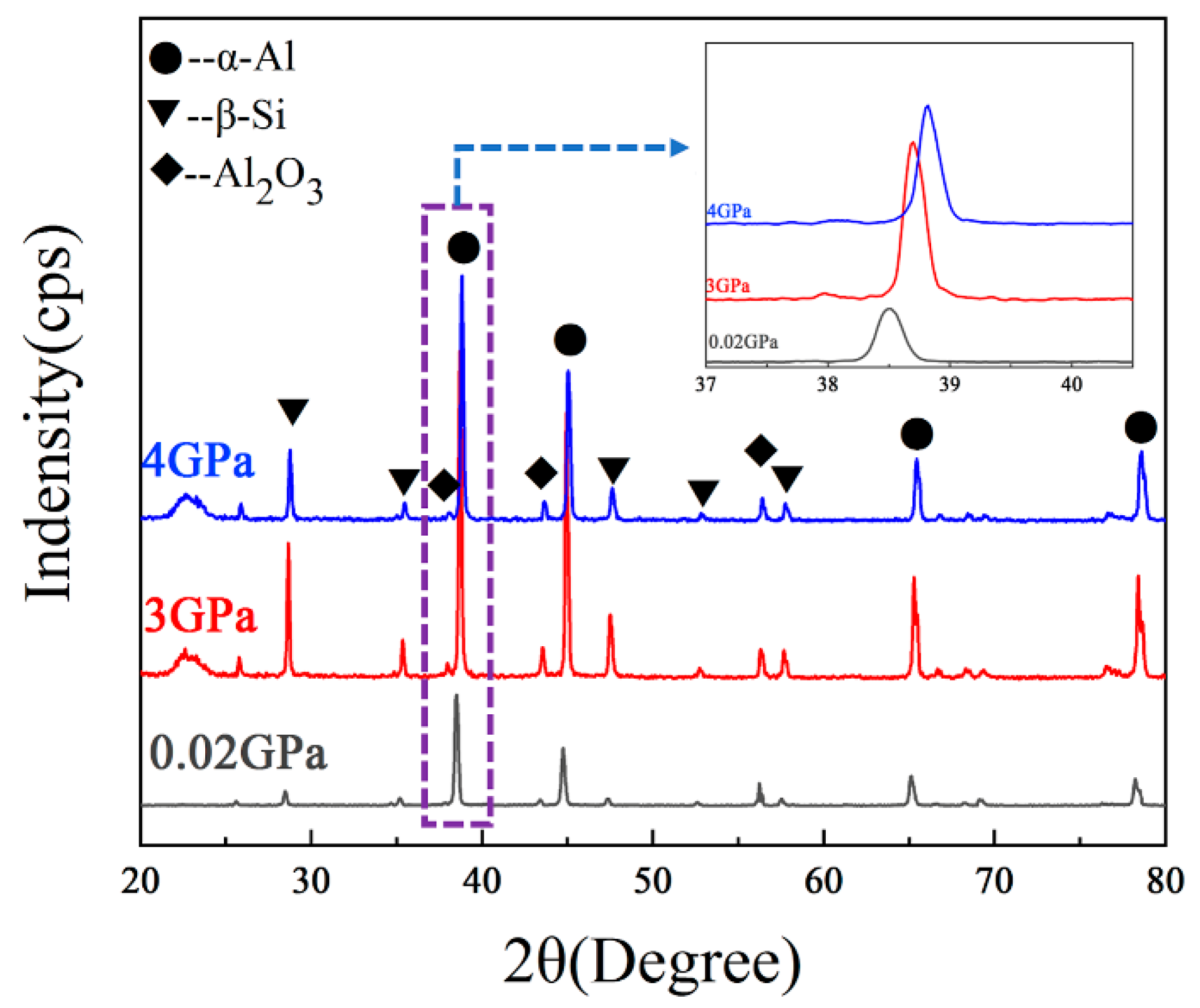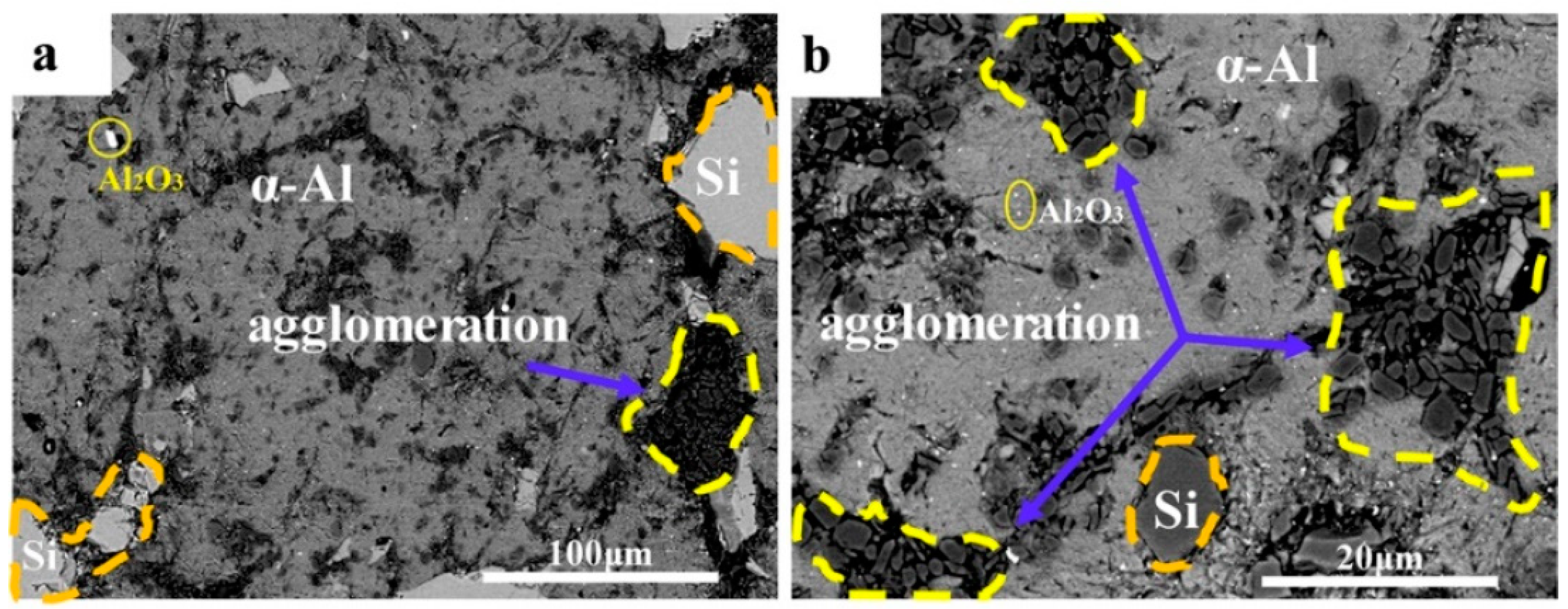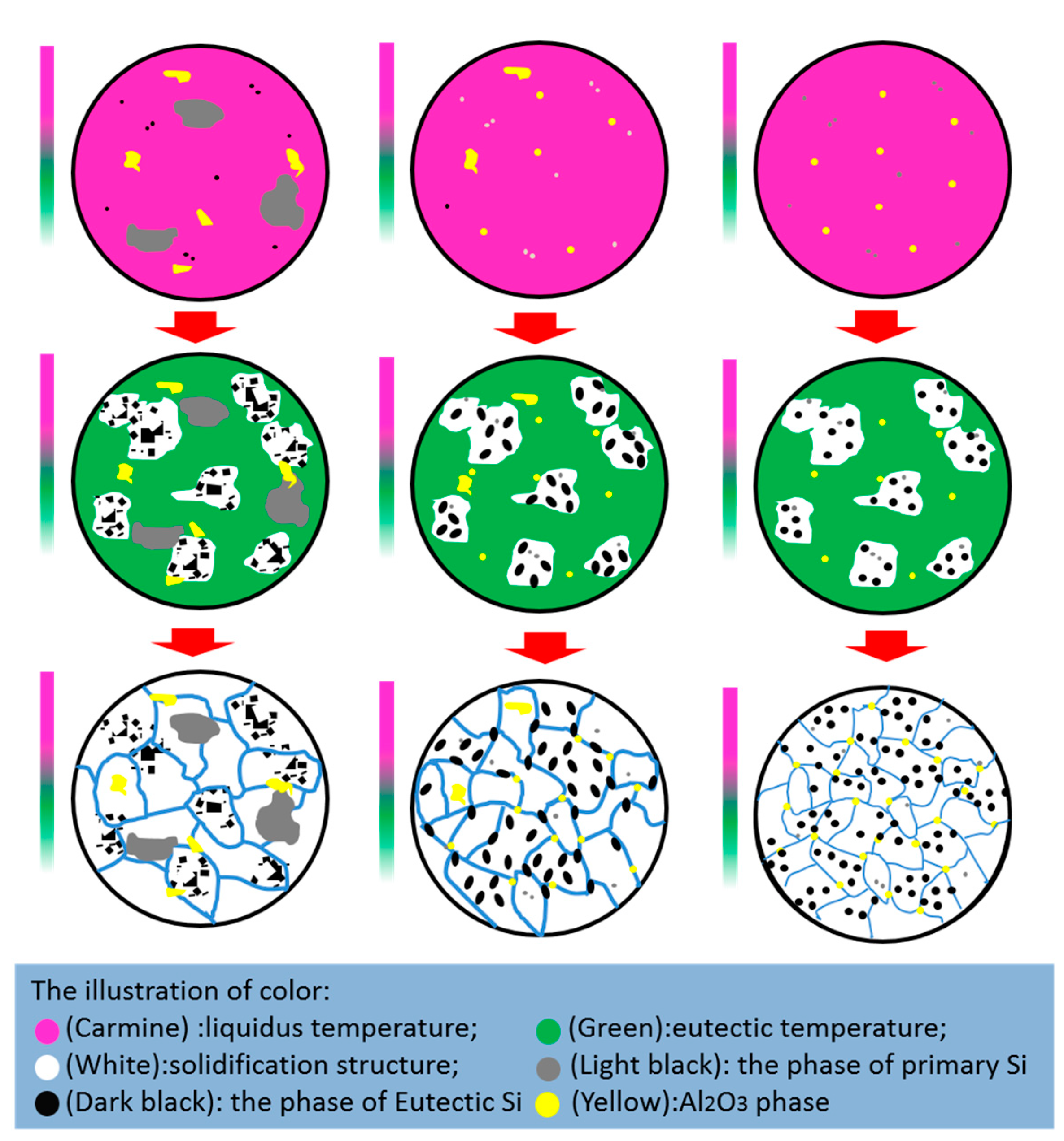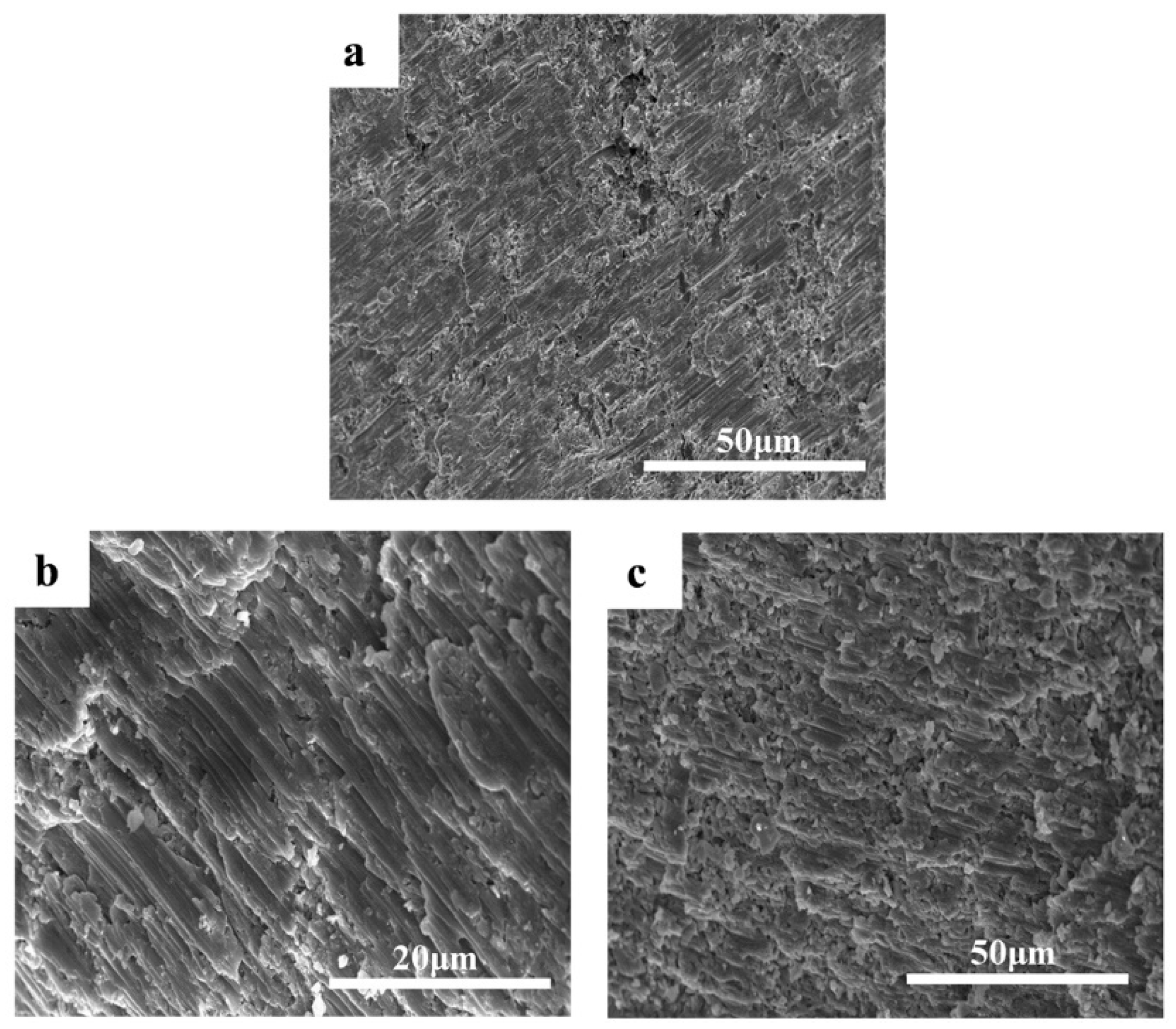Evolution of Primary and Eutectic Si Phase and Mechanical Properties of Al2O3/Al-20Si Composites under High Pressure
Abstract
:1. Introduction
2. Materials and Methods
3. Results
3.1. Microstructure of Al2O3/Al-20Si Composites
3.2. Properties of Al2O3/Al-20Si Composites
3.2.1. Density of Composite
3.2.2. Microhardness of Composite
3.2.3. Compressive Strength of Composite
3.2.4. Fracture Mechanism of Al2O3/Al-20Si Composites
4. Conclusions
Author Contributions
Funding
Data Availability Statement
Conflicts of Interest
References
- Wei, Z.J.; Ma, P.; Wang, H.W.; Zou, C.M.; Scudino, S.; Song, K.; Prashanth, K.G. The thermal expansion behaviour of SiCp /Al–20Si composites solidified under high pressures. Mater. Des. 2015, 65, 387–394. [Google Scholar] [CrossRef]
- Zeng, J.; Zhu, C.Y.; Wang, W.L.; Li, X.; Li, H.L. Evolution of primary Si phase, surface roughness and mechanical properties of hypereutectic Al-Si alloys with different Si contents and cooling rates. Phi. Mag. Lett. 2020, 100, 581–587. [Google Scholar] [CrossRef]
- Li, M.J.; Omura, N.; Murakami, Y.; Matsui, I.; Tada, S. A comparative study of the primary phase formation in Al-7 wt% Si and Al-17 wt% Si alloys solidified by electromagnetic stirring processing. Mater. Today Commun. 2020, 24, 101146. [Google Scholar] [CrossRef]
- Langelandsvi, K.G.; Horgar, A.; Furu, T.; Roven, H.J.; Akselsen, O.M. Comparative study of eutectic Al-Si alloys manufactured by WAAM and casting. Int. J. Adv. Manuf. 2020, 110, 935–947. [Google Scholar] [CrossRef]
- Zhang, B.; Zhao, Y.H.; Wang, H.; Chen, W.P.; Hou, H. Three-Dimensional Phase Field Simulation of Dendritic Morphology of Al-Si Alloy. Rare Met. Mater. Eng. 2019, 48, 2835–2840. [Google Scholar]
- Zhang, H.T.; Zuo, K.S.; Han, X. Effects of P+Cr complex modification and solidification conditions on microstmcture of hypereutectic Al-Si alloys by wedge-shaped copper mould casting. China Foundry 2014, 11, 481–486. [Google Scholar]
- Chen, C.; Liu, Z.X.; Ren, B.; Wang, M.X.; Weng, Y.G.; Liu, Z.Y. Influences of complex modification of P and RE on microstructure and mechanical properties of hypereutectic Al-20Si alloy. Nonferr. Met. Soc. 2007, 17, 301–306. [Google Scholar] [CrossRef]
- Xu, C.L.; Jiang, Q.C.; Yang, Y.F.; Wang, H.Y.; Wang, J.G. Effect of Nd on primary silicon and eutectic silicon in hypereutectic Al-Si alloy. J. Alloys Compd. 2006, 422, L1–L4. [Google Scholar] [CrossRef]
- Barrirero, J.; Li, J.H.; Engstler, M.; Ghafoor, N.; Schumacher, P.; Oden, M.; Mucklich, F. Cluster formation at the Si/liquid interface in Sr and Na modified Al-Si alloys. Scripta Mater. 2016, 117, 16–19. [Google Scholar] [CrossRef] [Green Version]
- Wei, H.M.; Geng, L.; Zhang, X.X. Solidification behavior of SiCw/Al-18Si composites, Rare Met. 2007, 26, 237–241. Rare Met. 2007, 26, 237–241. [Google Scholar]
- Lien, H.H.; Mazumder, J.; Wang, J.; Misra, A. Ultrahigh strength and plasticity in laser rapid solidified Al-Si nanoscale eutectics. Mater. Res. Lett. 2020, 8, 291–298. [Google Scholar] [CrossRef]
- Tian, J.T.; Piñero, E.; Narciso, J.; Louis, E. Effects of temperature on pressure infiltration of liquid Al and Al-12 wt.% Si alloy into packed SiC particles. Scripta Mater. 2005, 53, 1483–1488. [Google Scholar] [CrossRef]
- Yan, W.; Chen, W.Q.; Zhang, S.L.; Li, B.; Li, J. Evolution of solidification structures and mechanical properties of high-Si Al alloys under permanent magnetic stirring. Mater. Charact. 2019, 157, 109894. [Google Scholar] [CrossRef]
- Haghayeghi, R.; de Paula, L.C.; Zoqui, E.J. Comparison of Si Refinement Efficiency of Electromagnetic Stirring and Ultrasonic Treatment for a Hypereutectic Al-Si Alloy. J. Mater. Eng. Perform. 2017, 26, 1900–1907. [Google Scholar] [CrossRef]
- Selivorstov, V.; Dotsenko, Y.; Borodianskiy, K. Influence of Low-Frequency Vibration and Modification on Solidification and Mechanical Properties of Al-Si Casting Alloy. Materials 2017, 10, 560. [Google Scholar] [CrossRef] [Green Version]
- Choi, H.; Konishi, H.; Li, X. Al2O3 nanoparticles induced simultaneous refinement and modification of primary and eutectic Si particles in hypereutectic Al–20Si alloy. Mater. Sci. Eng. A 2012, 541, 159–165. [Google Scholar] [CrossRef]
- Li, Q.; Xia, T.; Lan, Y.; Zhao, W.; Fan, L.; Li, P. Effect of in situ γ-Al2O3 particles on the microstructure of hypereutectic Al−20%Si alloy. J. Alloys Compd. 2013, 577, 232–236. [Google Scholar] [CrossRef]
- Megahed, M.; Saber, D.; Agwa, M.A. Modeling of Wear Behavior of Al-Si/Al2O3 Metal Matrix Composites. Phys. Met. Metallogr. 2019, 120, 981–988. [Google Scholar] [CrossRef]
- Choi, H.; Li, X. Refinement of primary Si and modification of eutectic Si for enhanced ductility of hypereutectic Al−20Si−4.5Cu alloy with addition of Al2O3 nanoparticles. J. Mater. Sci. 2012, 47, 3096–3102. [Google Scholar] [CrossRef]
- Bramfitt, B.L. The effect of carbide and nitride additions on the heterogeneous nucleation behavior of liquid iron. Metall. Trans. 1970, 1, 1987–1995. [Google Scholar]
- Wang, X.H.; Ran, Z.; Wei, Z.J.; Zou, C.M.; Wang, H.W.; Gouchi, J.; Uwatoko, Y. The formation of Bulk β-Al3Ni phase in eutectic Al-5.69wt%Ni solidified under high pressure. J. Alloys Compd. 2017, 42, 670–675. [Google Scholar] [CrossRef]
- Wang, X.H.; Wang, H.W.; Zou, C.M.; Wei, Z.J.; Uwatoko, Y.; Gouchi, J. The effect of high pressure and superheating and superheating on the planar growth of Al3Ni phase in hypo-peritectic Al-30wt%Ni alloy. J. Alloys Compd. 2019, 772, 1052–1060. [Google Scholar] [CrossRef]
- Wang, X.H.; Wang, H.W.; Wei, Z.J.; Zou, C.M. Al3Ni alloy synthesized at high pressure and its Debye temperature. J. Alloys Compd. 2019, 774, 364–369. [Google Scholar] [CrossRef]
- Zhu, D.D.; Dong, D.; He, Q.; Zhou, Z.Z.; Zhang, Y.X.; Wang, Q.B.; Ni, C.Y. Instability mechanism of lamellar structures of Ti-48Al alloy solidified under high pressure. Rare Met. Mater. Eng. 2017, 46, 217–220. [Google Scholar]
- Ma, P.; Zou, C.M.; Wang, H.W.; Scudino, S.; Fu, B.G.; Wei, Z.J.; Kuhn, U.; Eckert, J. Effects of high pressure and SiC content on microstructure and precipitation kinetics of Al–20Si alloy. J. Alloys Compd. 2014, 586, 639–644. [Google Scholar] [CrossRef]
- Lin, X.P.; Fan, Z.B.; Xu, C.; Yuo, G.K.; Guo, S.Q. Room temperature compressive properties and strengthening mechanism of Mg96.17Zn3.15Y0.50Zr0.18 alloy solidified under high pressure. J. Rare Earths 2020, 38, 657–664. [Google Scholar] [CrossRef]
- Liu, X.; Ma, P.; Jia, Y.D.; Wei, Z.J.; Suo, C.J.; Ji, P.C.; Shi, X.R.; Yu, Z.S.; Prashanth, G.K. Solidification of Al-xCu alloy under high pressures. J. Mater. Res. Technol. 2020, 9, 2983–2991. [Google Scholar] [CrossRef]
- Batashef, A.E. Crystallization of Metals and Alloys at Pressure, 1st ed.; Moscow Metallurgy: Moscow, Russia, 1977. [Google Scholar]
- Thompson, C.V.; Spaepen, F. Homogeneous crystal nucleation in binary metallic melts. Acta Met. 1983, 31, 2021–2027. [Google Scholar] [CrossRef]








| Phase | 0.02 GPa | 3 GPa | 4 GPa | ||||||
|---|---|---|---|---|---|---|---|---|---|
| Al (wt%) | Si (wt%) | O (wt%) | Al (wt%) | Si (wt%) | O (wt%) | Al (wt%) | Si (wt%) | O (wt%) | |
| Matrix | 98.06 | 1.94 | 0 | 96.57 | 3.43 | 0 | 96.06 | 3.94 | 0 |
| Bulk grey phase | 1.55 | 98.45 | 0 | 1.61 | 98.39 | 0 | 1.40 | 98.60 | 0 |
| White phase | 53.11 | 2.88 | 44.01 | 51.62 | 2.67 | 45.71 | 51.38 | 2.56 | 46.06 |
| Pressure | 0.02 GPa | 3 GPa | 4 GPa |
|---|---|---|---|
| Density (g/cm3) | 2.52 | 2.63 | 2.78 |
Publisher’s Note: MDPI stays neutral with regard to jurisdictional claims in published maps and institutional affiliations. |
© 2021 by the authors. Licensee MDPI, Basel, Switzerland. This article is an open access article distributed under the terms and conditions of the Creative Commons Attribution (CC BY) license (https://creativecommons.org/licenses/by/4.0/).
Share and Cite
Wang, X.; Chen, Z.; Ma, T.; Zhu, D.; Dong, D.; Yang, X.; Liu, L.; Wang, G. Evolution of Primary and Eutectic Si Phase and Mechanical Properties of Al2O3/Al-20Si Composites under High Pressure. Crystals 2021, 11, 364. https://doi.org/10.3390/cryst11040364
Wang X, Chen Z, Ma T, Zhu D, Dong D, Yang X, Liu L, Wang G. Evolution of Primary and Eutectic Si Phase and Mechanical Properties of Al2O3/Al-20Si Composites under High Pressure. Crystals. 2021; 11(4):364. https://doi.org/10.3390/cryst11040364
Chicago/Turabian StyleWang, Xiaohong, Zhipeng Chen, Tengfei Ma, Dongdong Zhu, Duo Dong, Xiaohong Yang, Li Liu, and Gang Wang. 2021. "Evolution of Primary and Eutectic Si Phase and Mechanical Properties of Al2O3/Al-20Si Composites under High Pressure" Crystals 11, no. 4: 364. https://doi.org/10.3390/cryst11040364
APA StyleWang, X., Chen, Z., Ma, T., Zhu, D., Dong, D., Yang, X., Liu, L., & Wang, G. (2021). Evolution of Primary and Eutectic Si Phase and Mechanical Properties of Al2O3/Al-20Si Composites under High Pressure. Crystals, 11(4), 364. https://doi.org/10.3390/cryst11040364






